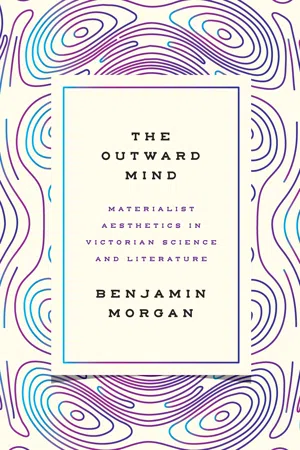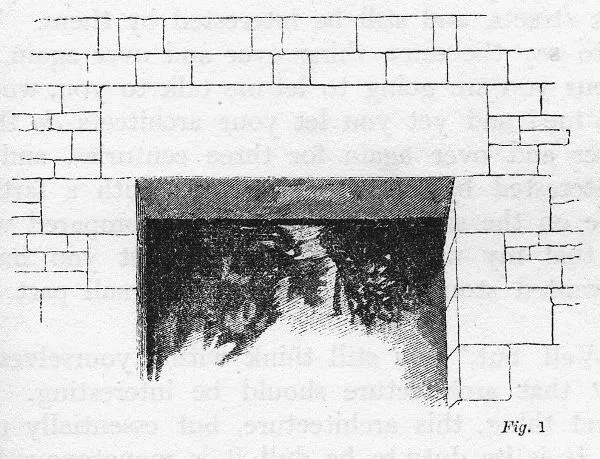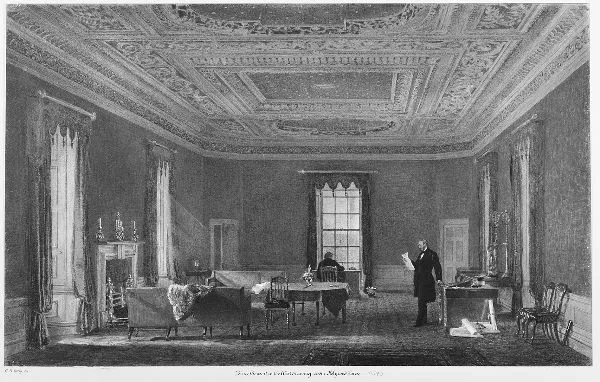![]()
Part One: Toward a Science of Beauty
![]()
1
Form: Harmony and Attunement in Empirical Aesthetics
On November 1, 1853, the day of his first public lecture, John Ruskin walked down Edinburgh’s Queen Street and counted the windows.1 There were 678 along one side of the street, and all were nearly identical square-cut openings topped by a heavy lintel (fig. 1.1). When Ruskin reported this fact to his overflowing audience that evening, he invited them to consider the advantages of a more varied architecture: “It is by no means a bad form,” he observed, “but I cannot say it is entertaining.”2 This was the subversive argument of the recently completed Stones of Venice writ small: the rational symmetry of the Renaissance was inferior to unruly gothic expressiveness.
During Ruskin’s visit, James Young Simpson, a well-known anesthesiologist, offered to arrange a meeting between Ruskin and David Ramsay Hay, Edinburgh’s most famous interior decorator, whom Simpson knew through a club that meet monthly to discuss how scientific thought could be brought to bear on questions of taste. There is no record of whether this meeting took place—but if it did, it cannot have gone well. Then near the end of a successful career, Hay had published over a dozen books expounding what he called “the science of beauty,” a system of rules for color harmony and architectural design that had gained purchase throughout Britain: the interiors of Walter Scott’s Abbotsford and of Holyroodhouse Palace in Edinburgh had both been designed according to Hay’s principles (fig. 1.2). Hay’s theory, taking a cue from Pythagoras, was that visual beauty was subject to definite rules. These rules were discoverable through geometry, mathematics, and empirical observation, and they ought to be understood by practitioners of the fine and decorative arts. They explained not only complex instances of beauty, such as classical sculpture, but also the more rudimentary feeling that a room or environment was pleasing. Some angles induced such feelings of comfort and some did not; the proper mathematical and geometrical models could explain why. “If you can kindly come and bring some sketches or diagrams with you . . . , [Phillip] Kelland will be there and assist in the mathematics if required,” Simpson suggested in a letter to Hay, as he anticipated explaining the math to Ruskin.3
Ruskin, though he had rules of his own, understood them to have a very different origin and force: social rather than mathematical; organic rather than transcendental. Ruskin’s rules were not about which architectural angles were objectively most perfect but rather about the most perfect social conditions under which architecture might serve as a medium of individual expression. Hay’s notion that decorators should execute designs based on a rigid system of color and formal harmonies represented the exact sort of thing that dismayed Ruskin when he saw the uniform windows lining Queen Street. In fact, Ruskin parodied systems like Hay’s in his lecture when he presented an image of what a tree branch would look like if it grew “according to the received Attic architectural rules” (fig. 1.3).4
In this chapter I examine a widely shared aspiration in mid-nineteenth-century Britain to develop an empirical science of beauty. This project represents a significant alternative to Ruskin’s thought and can be traced through a network of intellectuals related to Hay. For many who wished to transform aesthetics into a science, superstructures such as culture or society were understood as secondary determinants of aesthetic judgment—mere inflections of the permanent and universal natural laws actually governing taste. Scientific aesthetics participates in what Robin Collingwood described as a history of attempts to develop an empirical “science of human nature” (in his view, impossible), which had been an object of aspiration among philosophers including Locke and Hume since the advent of Newtonian physical science.5 And the notion that harmonious beauty creates a mood of attunement to a milieu or atmosphere has an even longer lineage in Western thought, which has been traced by Leo Spitzer’s histories of the ideas of ambiance, milieu, and Stimmung.6 Between the 1840s and 1860s, these ideas gained purchase among scientifically minded intellectuals ranging from Hay and George Field (a color manufacturer) to Thomas Laycock (physiologist), John Addington Symonds Sr. (physician), and Eneas Sweetland Dallas (literary critic). The following pages approach the history of aesthetics from an oblique angle, focusing on vernacular attempts to understand the aesthetic that were parallel but ultimately also peripheral to the more influential projects of Ruskin and the Pre-Raphaelites.
The idea of aesthetic form takes on an unusual cast in the context of empirical aesthetics. It is simultaneously a complex structure or pattern that must be discerned through careful contemplation and analysis and an ambient effect of a lived environment apprehended automatically and sometimes even unconsciously. Reconceived as an arrangement of one’s surroundings that induces a physiological response, form draws near to a topos in philosophies of aesthetics and of the emotions from which it usually seems very distinct: the idea of Stimmung, an atmosphere or mood that takes place as the attunement of a being to an environment.7 If we recognize geometrically oriented work such as Hay’s as an attempt to mathematize Stimmung or atmosphere, we can understand it as an unusual conflation of the empirical and the ineffable. By tracing a lineage of scientific thought about the aesthetic, I show how this aspiration to uncover a formal patterning in nature eventually extended to an interest in a physiological patterning of the body and the nervous system, whose attunement or nonattunement to nature’s forms provided one explanation for the experience of beauty or ugliness.
What is conceptually intriguing about a notion of form as simultaneously ambient and geometrical is the apparently conflicting nature of its guiding assumptions: even as these writers embraced the idea that beauty and taste are susceptible to highly systematic and rational explanation, they simultaneously attributed a central role to nonconscious or semiconscious states of awareness, which are rarely imagined as contributing to rational thought. Complex order could be automatically apprehended and decoded by the body. Importantly (and perhaps surprisingly, for post-Freudian readers), the unconscious therefore came to represent a domain of hidden rationality where beauty and reason coincide. The aesthetic unconscious was multifaceted. It involved a concordance between mind and nature whose subjective manifestation is a feeling of pleasure, a peripheral apprehension of surrounding environments that do not fully come into awareness, and physicalized cerebral activity described by mental physiologists as “unconscious cerebration.” These aspects of the unconscious allow us to understand how aesthetic form could be thought of as inaccessible to the conscious mind even as this process of apprehension was imagined as more rational than most of conscious thought.
This conception of form provides a basis for a counter-Ruskinian framing of artistic modernity in which the artistically modern is not allied with anti-industrialist or progressive political positions but rather with forward-looking scientific theories. A significant critical context for my argument in this chapter is a line of reasoning about the political valences of design and aesthetics in the context of mid-nineteenth-century British industrialism. The displacement of the mimetic function of human-made art by machine-made photographs; new evidence that the human eye was incapable of faithful transmitting the surrounding world; a system of industrial manufacture that was rapidly replacing handicraft; the rise of print as a mass medium and the literary eclipse of poetry by the novel: all of these changes demanded new ways of thinking about how art should be defined and what role it could play in an emerging technological and scientific modernity.8 It has therefore often been observed that writing about aesthetics was in many cases a proxy for much larger questions about industrial modernity, especially for Ruskin. In his two major early works, Modern Painters and The Stones of Venice, Ruskin repeatedly placed a high value on individual expression within the context of collective labor and emphasized what humans can make and perceive that machines could not. To make this argument, Ruskin constructed a periodized historical narrative that is physically legible in architectural style; in principles of design one can also read principles of social organization. This is an elegant and famous formulation; alongside Marx, in Raymond Williams’s account, it is Ruskin, Augustus Pugin, and William Morris who invent an idea that is now almost taken for granted: art is historically produced from a given “way of life”; “aesthetic, moral, and social judgements are closely interrelated.”9 More recently, Jacques Rancière has described Ruskin’s thought as reconciling an opposition between art as decorative object (Kant) and art as symbolic expression (Hegel) by finding in decoration itself symbolic value.10 Ruskin has often been understood as originating a critical tradition in which the formal features of cultural objects make legible historical situations.
Scientific and empiricist aesthetics defamiliarize these narratives about the nineteenth century. If Ruskin made aesthetic form the index of a culture, many others imagined instead that it spoke to human capacities entirely unconditioned by history. Particularly insofar as scientific aesthetics draws on studies of the body and the nervous system, its desire to reconcile the human sense of beauty with natural laws resonates more fully with recent aesthetic and cultural theorists who have drawn on neuroscience and evolutionary psychology than with the historicist and politically oriented cultural and aesthetic theory of William Morris, E. P. Thompson, Raymond Williams, Terry Eagleton, and many others who take up aspects of Ruskin’s thought.11 Hay, by contrast with Ruskin, called on principles from design theory, medical research, and natural philosophy to prove his hypotheses. If aesthetic judgments are grounded in unchanging, lawful principles, then a notion of individual freedom such as Ruskin’s in “The Nature of Gothic,” which rejects rigid systems, is a false freedom. Tracing the antihistoricist logic of scientific aesthetics, in which laws of beauty are permanent and universal, therefore brings into view a different set of assumptions about what it meant to be aesthetically modern: not a politically inflected modernism in which art modeled or prefigured a transformed society but a scientific modernism in which advancing understandings of the natural world would finally produce a definitive explanation of the human experience of beauty.
Distinctive conceptual possibilities became available within the scientific tradition, particularly with regard to the relationship between aesthetic form and aesthetic feeling. As recent literary scholarship has reclaimed the value of attending closely to aesthetic and literary form, it has often focused on the recovering the political potential of form and formalism, which might be located in an attention to how seemingly self-contained aesthetic forms falsely resolve entrenched social and political contradictions, in explorations of dissonances or “collisions” between social and cultural forms, or in the idea that seemingly formalist “reflection on the precise way things are said or shown” should itself be understood as a politically engaged practice.12 This recent work usually understands the practice of attending to form as requiring complex and sophisticated acts of reflection and cognition. Empirical aesthetics, which values laws of proportion and harmony, reveals a complex and unpredictable relationship between politics and form in the context of British aesthetic thought in which identifying the formal patterning of nature originally accorded with natural theology but eventually became surprisingly and uncomfortably allied with a materialist (and potentially antitheological) neurophysiological conception of the human mind and emotions. Accounts of form as ambient often generated dialectical movements between abstraction and materiality, between form as an ideal, unseeable pattern and as a physiologized mood or emotion produced by concrete arrangements of sound, shape, or color. The conceptual richness of scientific aesthetics lies in part in its capacity to yield an idea of form not as the structure of a discrete object but as an interaction between the formal patterns of the nervous system and of its environments.
Harmony and Form in Natural Theology
If you place a piece of black metal on a speaker, pour some salt on it, and play a constant pitch, something remarkable happens: the salt organizes itself into perfectly regular geometric patterns. Even more remarkably, if you raise the pitch, the patterns will become increasingly ornate (fig. 1.4). This demonstration, first popularized in the late eighteenth century by the German physicist Ernst Chladni, was later used to demonstrate a key principle of natural philosophy: that there was, as the editors of a recent book on science and romanticism put it, “a direct analogy between aesthetic intuition and the intuition of nature.”13 Visible order, symmetry, and regularity bespoke a world that was divinely organized; aesthetic pleasure could be felt by apprehending that regularity whether it took the form of knowledge about the natural world or the more visible patterns on Chladni’s plates. Robert Richards describes romantic biology in Germany as developing Kant’s account of the “logical similarity between teleological judgment and aesthetic judgment. . . . Artistic experience and expression might operate in harmony with scientific experience and expression: the basic structures of nature might thus be apprehended and represented by the artist’s sketch and the poet’s metaphor, as well as by the scientist’s experiment and the naturalist’s observation.”14




